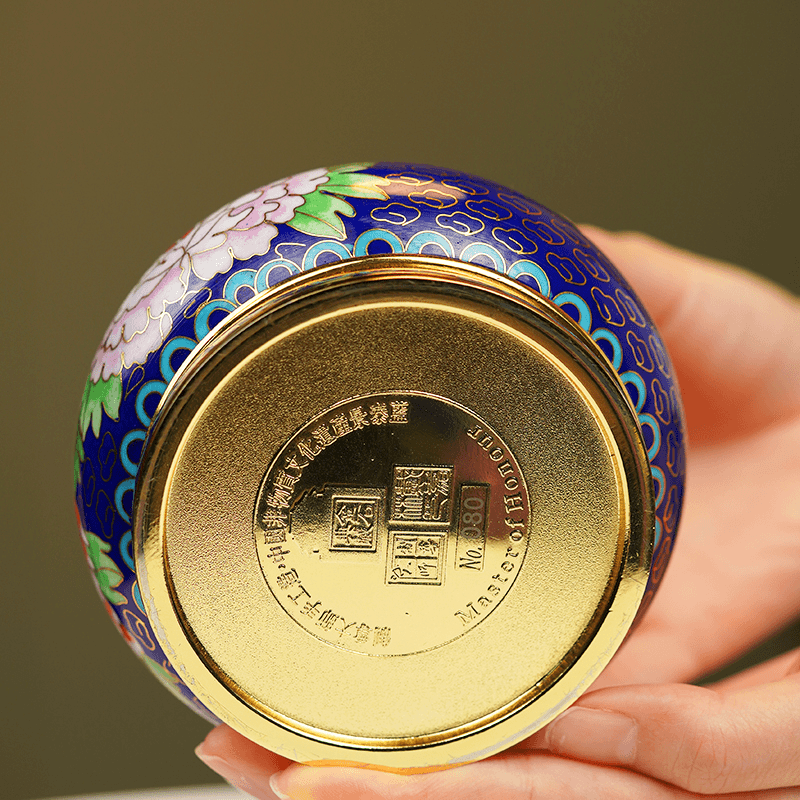Hansculture
A cloisonné tea caddy made entirely by hand by a high-end Chinese copper cloisonné enamel master
A cloisonné tea caddy made entirely by hand by a high-end Chinese copper cloisonné enamel master
Couldn't load pickup availability

Cloisonné is the first of the four famous Chinese arts and crafts, and is exclusively used by the royal family and nobles. It is a symbol of power and status.
There is a saying in the collection world, "One piece of cloisonné is equivalent to ten pieces of official kiln wares", "If you don't have cloisonné in your collection, it's useless to collect all the world's wares"


Cloisonne is a world-renowned Chinese special metal handicraft, and its official name is "copper-based cloisonne enamel". It was popular during the Jingtai period of the Ming Dynasty and has always been enjoyed exclusively by the royal family. It has never left the inner courtyard of the imperial palace for 600 years. It is a representative work of ancient Chinese court art and is known as the "most mysterious treasure" in ancient China. It is famous for its elegant and majestic shape, complex patterns, and elegant and solemn colors. It gives people a round, solid, delicate, neat, magnificent, and colorful artistic enjoyment. It is a world-renowned traditional handicraft. The artistic characteristics of cloisonne craftsmanship can be summarized in four words: shape, pattern, color, and light. It has a distinct national style and profound cultural connotations.
A masterpiece of craftsmanship.
Each piece is a treasure that cannot be replicated.
Masterpieces, one item, one certificate, one code.

Dai Jialin
The craftsmanship of the famous craftsman is worthy of the craftsmanship
The ingenious creation of the national master of Chinese cloisonné
Intangible Cultural Heritage Cloisonné Production, Representative Inheritor of the Skills
Master of Chinese Arts and Crafts
Beijing Arts and Crafts Master
Senior Arts and Crafts Artist and Chinese Intellectual Property Cultural Ambassador
Member of the Standing Committee of Metal Art Committee of China Arts and Crafts Association
The beauty of intangible cultural heritage
Art Master-Dai Jialin's creation
Representative inheritor of the intangible cultural heritage cloisonné production technique
Master of Chinese Arts and Crafts
Beijing Special Arts and Crafts Master
China's Cloisonne "Color First"

Master Dai Jialin is good at effectively combining cloisonné craftsmanship with the line drawing techniques of fine brushwork. The creation of the "hanging decoration method" makes the works vivid and full of vitality, especially in the use of color. Today's cloisonné industry is worthy of being a model.
This time, we strive to innovate and perfectly combine Chinese jade culture and cloisonné art, which represents the innovative significance of the times and has artistic value.

In recent years, cloisonné has been very popular in international auctions, and famous artists are competing to collect it.
Ming Jingtai Blue Duomu Pot, transaction price: 3.696 million
Ming Wanli cloisonné enamel hexagonal box with orange pattern, transaction price: 3.7 million
Qing Qianlong cloisonné enamel lotus pattern prayer wheel, transaction price: 5.134 million
Qing Qianlong copper-based cloisonné enamel three-legged lid, transaction price: 7.2504 million
Qing Qianlong cloisonné enamel lotus pattern butter tea lidded jar, transaction price: 11.4056 million
The copper-based cloisonné enamel sculpture of two cranes presented by Emperor Yongzheng to Emperor Kangxi was sold for HK$129 million. Such rare treasures handed down from generation to generation are all masterpieces of Chinese culture.
The shockingly high price, is it a sign of the demise of the national quintessence?
Share









